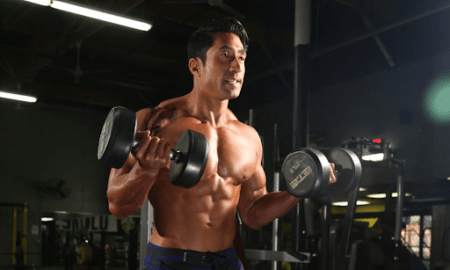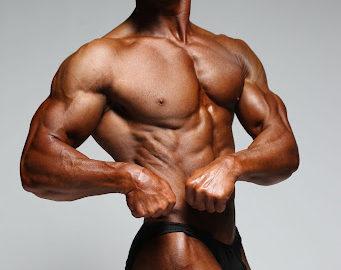Q: What are the best exercises for developing my forearms? I’m building some pretty big arms, but my forearms still look like sticks.
A: I like to compare the forearm with the calf. Both are located on the outer extremities of the body, both are often resistant to growth (basically most bodybuilders who have well-developed calves or forearms inherited them), and both are usually neglected in the gym. The forearms, however, are displayed much more than the calves (unless you wear shorts all year long), so developing massive forearms will go a long way toward adding to the impressiveness of your physique. They actually help your arms look bigger than they really are.
I like to compare the forearm with the calf. Both are located on the outer extremities of the body, both are often resistant to growth (basically most bodybuilders who have well-developed calves or forearms inherited them), and both are usually neglected in the gym. The forearms, however, are displayed much more than the calves (unless you wear shorts all year long), so developing massive forearms will go a long way toward adding to the impressiveness of your physique. They actually help your arms look bigger than they really are.
In designing a workout program for the forearms, you need to concern yourself with the extensor muscles, located on the top of the forearm (the brachioradialis and extensor carpi radialis, among others), and the flexor muscles on the bottom of the forearm (the flexor carpi radialis, flexor carpi ulnaris and the palmaris longus). You can train those two groups of muscles in one workout, or you can divide them into two separate workouts, since they perform different functions.
I like to train the extensor muscles on the same days that I train my biceps and the forearm flexors after my back workout. Of course, when I train back and biceps in the same workout, I train all the muscles in my forearms at the end of the session. My favorite exercises for the extensors are reverse curls, preacher reverse curls and hammer curls. In addition to developing the extensors, they build the brachialis, located between the biceps and triceps. I always do them after my biceps workout, since the brachialis is indirectly trained during biceps work.
You can perform reverse curls with a straight bar or a cambered curling bar. I think the cambered bar works better, since it slightly pronates the wrists, which makes the brachialis muscles work harder. It also makes the exercise much easier on the wrists, which can be strained when you do reverse curls with a straight bar.
To do hammer curls, you simply curl dumbbells while keeping your thumbs pointed toward the ceiling. I like to use a slightly different version of hammer curls in which I curl the dumbbell across my body in the direction of my opposite shoulder instead of straight up. That seems to affect the brachialis much more than the standard version.
Three sets of one of those exercises is all I need. I keep the reps between eight and 12, as the forearm muscles seem to respond better to slightly higher repetitions.
You use the flexor muscles of the forearms during exercises that require a strong grip. Since they get indirect work during my back workout, I train them immediately following it.
The best exercises for training the forearm flexors are standing wrist curls and seated wrist curls. I prefer the seated version because it enables me to really focus on the muscles I’m training.
Holding a barbell with my palms facing up, I rest my forearms on a bench, positioning my arms so my wrists are at the end of the bench. I squeeze my elbows between my knees so my arms are locked in and so I can concentrate on training my forearms. I curl the barbell with my wrists until the forearms are fully contracted before I roll the bar back to the starting position. When I can no longer perform a full rep, I open my hands in the bottom position and let the barbell roll down to the ends of my fingers. From there I perform half reps, followed by quarter reps, and keep going until I literally drop the bar. At the end of my set my forearms are on fire!
When I started training, the bodybuilder with the biggest forearms was the Incredible Hulk himself, Lou Ferrigno. Lou used to perform seated wrist curls with 225 pounds, and he had the forearms to show for it. When Lou cocked his wrist and flexed his forearm, it measured an incredible 19 inches!
Although these exercises will help pack on more lower-arm mass, you’ll also build some serious size simply by performing basic barbell and dumbbell exercises. Deadlifts, shrugs, barbell rows, dumbbell rows, chins, upright rows and lateral raises will indirectly develop the forearms. Mike Mentzer, although undoubtedly very genetically gifted, often boasted that he did no direct forearm work, but his forearm muscles were developed by performing heavy basic exercises. Use the basic exercises with heavy weights along with some direct lower-arm movements, and you’ll forge a pair of fantastic forearms.
Q: Could you please look over my training routine and let me know if it’s good for putting on size? I’ve been training very hard for the past three years, but I’m still stuck at 180 pounds. I desperately want to get to 200 by the summer. Here’s how I’m training now: Monday: chest and abs; Tuesday: arms; Wednesday: back; Thursday: legs; Friday: shoulders and traps; Saturday and Sunday: off.
A: I think you’re training too many days in a row to put on the size you’re looking for. It also looks as if you’re not training your bodyparts in the correct order to avoid overtraining. For example, you train arms the day before you train your back. Since the biceps are strongly involved in back training, how can you effectively train your back with heavy resistance the day after you bomb your biceps? Another example is training your legs the day after you train your back. If you’re using basic movements such as barbell rows, T-bar rows and deadlifts, you should (if you trained hard enough) have a difficult time using heavy weights on squats and stiff-legged deadlifts the very next day.
I think you’re training too many days in a row to put on the size you’re looking for. It also looks as if you’re not training your bodyparts in the correct order to avoid overtraining. For example, you train arms the day before you train your back. Since the biceps are strongly involved in back training, how can you effectively train your back with heavy resistance the day after you bomb your biceps? Another example is training your legs the day after you train your back. If you’re using basic movements such as barbell rows, T-bar rows and deadlifts, you should (if you trained hard enough) have a difficult time using heavy weights on squats and stiff-legged deadlifts the very next day.
You have to take into account all the muscles you’re affecting when you train a certain bodypart. A chest workout involves not only the pecs but also the triceps and deltoids. A heavy-duty back workout will affect the lats, the lower back, the biceps and the rear delts. Training legs effectively requires help from the lower back, glutes and hamstrings as well as the quadriceps. As you can see, no bodypart is an island (to paraphrase poet John Donne).
I always design my workouts so I’m training my delts two to three days after my chest workout. Similarly, my leg workout always precedes my back workout by at least two days. Separating workouts that involve many of the same bodyparts helps to avoid overtraining and injury.
You also need to take into account recuperation for the body as a whole. You’re currently training five days in a row. Every time you train, you stress your nervous system as well as the muscles. I think you would gain more size and strength by taking a day off after every two workouts. That would allow your body to recuperate and grow.
Give this routine a try and see if it works better for you:
Monday: Chest and triceps
Tuesday: Legs
Wednesday: Off
Thursday: Deltoids, traps and calves
Friday: Back and biceps
Saturday and Sunday: Off
The schedule is structured so you’ll avoid injury and overtraining. You have three days separating your chest and shoulder workouts and three days between your leg and back workouts. You also take a complete day of rest every third day to help with the recuperation process. In fact, this routine is designed so you take your rest days after training the biggest bodyparts (legs and back). Those workouts probably take the most out of you and cause the biggest depletion to your body as a whole.
Now that you have the right workout routine, it’s up to you to use the best exercises and train with intensity. Push yourself to use heavier poundages, and keep the sets moderate so you avoid overtraining. Eat enough calories, especially protein and complex carbs, split over six meals per day, and you’ll be on your way to reaching your 200-pound goal.
Editor’s note: John Hansen has won the Natural Mr. Olympia and is a two-time Natural Mr. Universe winner. Visit his Web site at www.naturalolympia.com. You can write to him at P.O. Box 3003, Darien, IL 60561, or call toll-free 1-800-900-UNIV (8648). IM




















You must be logged in to post a comment Login